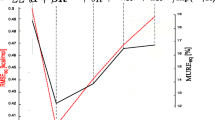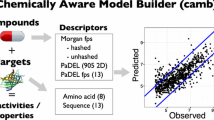Summary
The steric descriptors commonly used in CoMFA — Lennard-Jones 6–12 potential-derived interaction energies calculated between a probe atom and the molecules under investigation — have been replaced by variables indicating the presence of an atom of a particular molecule in predefined volume elements (cubes) within the region enclosing the ensemble of superimposed molecules. The resulting ‘atom indicator vectors’ were used as steric fields in the subsequent PLS analyses, with and without inclusion of electrostatic Coulomb interaction-derived fields. Application of this method to five training sets (80 compounds each) and five test sets (60 compounds each), randomly selected from an ensemble of 256 dihydrofolate reductase inhibitors, leads to models of significantly higher consistency, as indicated by the cross-validated r2 values for the training sets and the predictive r2 values for the test sets.
Similar content being viewed by others
References
CramerIII, R.D., Patterson, D.E. and Bunce, J.E., J. Am. Chem. Soc., 110 (1988) 5959. For applications of CoMFA in medicinal chemistry, see for instance Refs. 2–7:
Avery, M.A., Gao, F. and Chong, W.K.M., J. Med. Chem., 36 (1993) 4264.
Horwitz, J.P., Massova, I., Wiese, T.E., Besler, B.H. and Corbett, T.H., J. Med. Chem., 37 (1994) 781.
Waller, C.L., Oprea, T.I., Giolitti, A. and Marshall, G.R., J. Med. Chem., 36 (1993) 4152.
Waller, C.L. and Marshall, G.R., J. Med. Chem., 36 (1993) 2390.
DePriest, S.A., Mayer, D., Naylor, C.B. and Marshall, G.R., J. Am. Chem. Soc., 115 (1993) 5372.
Debnath, A.K., Hansch, C., Kim, K.H. and Martin, Y.C., J. Med. Chem., 36 (1993) 1007.
Wold, S., Ruhe, A., Wold, H. and DunnIII, W.J., SIAM J. Sci. Stat. Comput., 5 (1984) 735.
Wold, S., Albano, C., DunnIII, W.J., Edlund, U., Esbenson, K., Geladi, P., Hellberg, S., Johannson, E., Lindberg, W. and Sjörström, M., In Kowalski, B. (Ed.) Chemometrics: Mathematics and Statistics in Chemistry, Reidel, Dordrecht, 1984, pp. 17–95.
Stahle, L. and Wold, S., Prog. Med. Chem., 25 (1988) 292.
CramerIII, R.D., Patterson, D.E. and Bunce, J.D., Quant. Struct.-Act. Relatsh., 7 (1988) 18.
Thibaut, U., Folkers, G., Klebe, G., Kubinyi, H., Merz, A. and Rognan, D., Quant. Struct.-Act. Relatsh., 13 (1994) 1.
Snell, C., (1994) personal communication.
Marsili, M., Floersheim, P. and Dreiding, A.S., Comput. Chem., 7 (1983) 175.
Doweyko, A.M., J. Med. Chem., 31 (1988) 1396.
Silipo, C. and Hansch, C., J. Am. Chem. Soc., 97 (1975) 6849.
Kim, K.H. and Martin, Y.C., J. Med. Chem., 34 (1991) 2056.
Greco, G., Novellino, E., Silipo, C. and Vittoria, A., Quant. Struct.-Act. Relatsh., 10 (1991) 289.
Klebe, G. and Abraham, U., J. Med. Chem., 36 (1993) 70.
SYBYL Molecular Modelling Package, Version 6.04, TRIPOS Associates, St. Louis, MO, 1993.
Vinter, J.G., Davies, A. and Saunder, M.R., J. Comput.-Aided Mol. Design, 1 (1987) 31.
Powell, M.J.D., Math. Program., 12 (1977) 241.
Stewart, J.J.P. and Seiler, F.J., MOPAC (Version 5.00), QCPE Program No. 455, Quantum Chemistry Program Exchange, University of Indiana, Bloomington, IN, 1989.
Dewar, M.J.S. and Thiel, W., J. Am. Chem. Soc., 99 (1977) 4899.
SYBYL Molecular Modelling Software, Version 6.0 Theory Manual, Tripos Associates, St. Louis, MO, 1992, p. 2225.
CramerIII, R.D., DePriest, S.A., Patterson, D.E. and Hecht, P., In Kubinyi, H. (Ed.) 3D QSAR in Drug Design: Theory, Methods and Applications, ESCOM, Leiden, 1993, p. 465.
Calder, J.A., Wyatt, J.A., Frenkel, D.A. and Casida, J.E., J. Comput.-Aided Mol. Design, 7 (1993) 45.
Rault, S., Bureau, R., Pilo, J.C. and Robba, M., J. Comput.-Aided Mol. Design, 6 (1992) 553.
Wiese, M. and Coats, E.A., Pharmacochem. Libr., 16 (1991) 343.
Floersheim, P., Nouzlak, J. and Weber, H.P., In Wermuth, C.G. (Ed.) Trends in QSAR and Molecular Modelling 92 (Proceedings of the 9th European Symposium on Structure-Activity Relationships: QSAR and Molecular Modelling), ESCOM, Leiden, 1993, p. 227.
Author information
Authors and Affiliations
Rights and permissions
About this article
Cite this article
Kroemer, R.T., Hecht, P. Replacement of steric 6–12 potential-derived interaction energies by atom-based indicator variables in CoMFA leads to models of higher consistency. J Computer-Aided Mol Des 9, 205–212 (1995). https://doi.org/10.1007/BF00124452
Received:
Accepted:
Issue Date:
DOI: https://doi.org/10.1007/BF00124452




